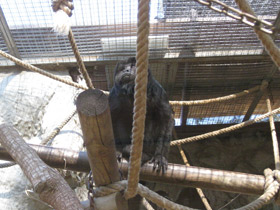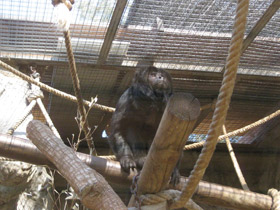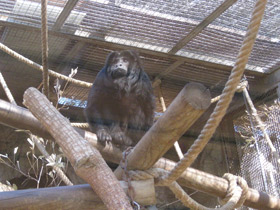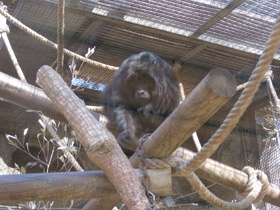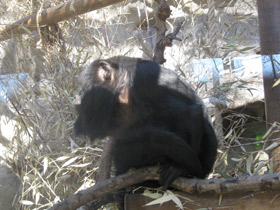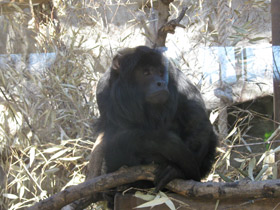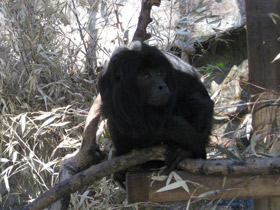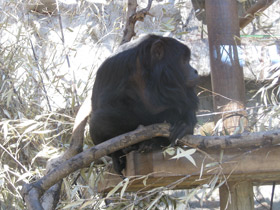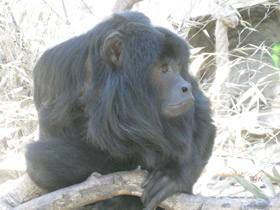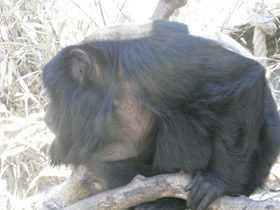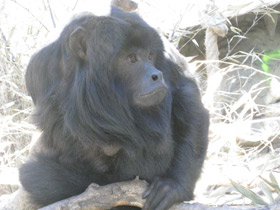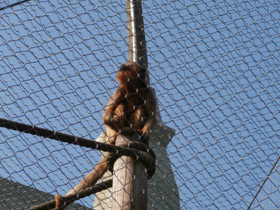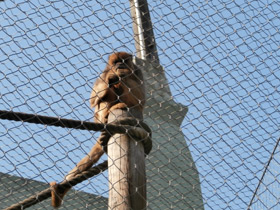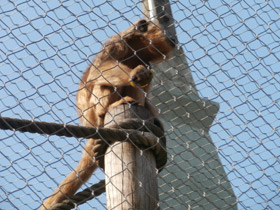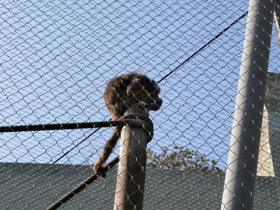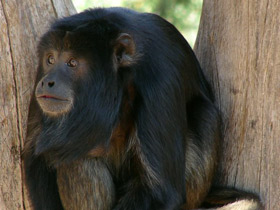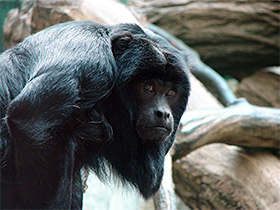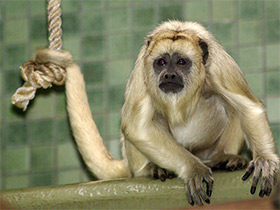The black howler (Alouatta caraya) or black-and-gold howler
The black howler (Alouatta caraya) or black-and-gold howler, is among the largest New World monkeys and a member of the Alouatta genus. The black howler is distributed in areas of South America such as Paraguay, southern Brazil, eastern Bolivia, northern Argentina, and Uruguay. This species is sexually dimorphic, with adult males having entirely black fur and adult females and babies of both sexes having an overall golden colouring; which emphasizes black-and-gold in the name. The IUCN Red List has classed the black howler as Near Threatened as a result of a recent population reduction due to a variety of human-caused factors.
Taxonomy
The black howler is one of nine species of the Alouatta genus that have been identified and is in the Atelidae family. Because of this species' sexual dimorphism, the taxon for the black howler has been distinguished.
- Alouatta caraya;
- Alouatta pigra;
- Alouatta seniculus;
- Alouatta arctoidea;
- Alouatta sara;
- Alouatta macconnelli;
- Alouatta guariba;
- Alouatta belzebul;
- Alouatta palliata.
Appearance and habitat area
The black howler (Alouatta caraya) is a species of platyrrhine primate of the family Atelidae. It is the southernmost species of all monkeys in the Americas and inhabits central South America. Alouatta caraya are found in southern America, in eastern Bolivia, southern Brazil, Paraguay and the savannahs of northern Argentina. These monkeys are called howler monkeys because of their thunderous song in the morning and evening hours. The Alouatta caraya has sexual dimorphism: males are black and females are yellowish brown. In addition, females are significantly smaller than males and account for about 80% of their size. The black face and the underside of the tail are almost hairless, but they have quite bushy eyebrows. The upper molars of Alouatta caraya have sharp scallops, which are used for grinding hard food. The Alouatta caraya has a body length of 1.3 m, of which the tail occupies half, and a weight of 4-10 kg.
Nutrition
The diet of the Alouatta caraya is dominated by leaves, fruits, shoots and flowers. Alouatta caraya rarely come down from the trees, where they feed and sleep. During the dry season, these primates go to the watering holes of lakes, where they feed on wetland plants. In addition to fruits, seeds and grasses, they also eat insects, eggs and chicks.
Behaviour and peculiarities
In the forest, the Alouatta caraya moves slowly, almost crawling, climbing slowly from one branch to another, picking leaves and shoots, plucking them slowly with its hand and bringing them slowly to its mouth. Sometimes they lie along a branch, lowering their arms and legs on both sides of the branch and holding on only with their tail. The tail of the Alouatta caraya plays undoubtedly the most important role in the movement. Whatever position the monkeys adopt, they cling to something, hold on to it and attract various objects to themselves. When advancing on a branch or coming down from a tree, they hold on with their tails to a branch they are about to leave, until they find a new point of support with their hands, and when climbing a tree, they hold on with their tails to a lower branch until they firmly grasp the upper branch with their hands and paws. The tail of the Alouatta caraya is stronger than its arms and the muscles at its tip are so strong that they keep the tail permanently coiled, like a watch spring. The Alouatta caraya can hang from the end of its tail like a hook, wrapping it only halfway up one limb.
Mating
Mating behaviour and patterns of the black howlers have been identified. A study by Martin M. Kawoleski and Paul A. Garber in 2010 examined the promiscuity of black howler females along the Paraná River in Argentina using a scan sampling technique. According to the findings, sexual solicitation of female mate choice occurred when a female actively pursued a particular male by grooming, touching, and following him, and displaying a specific posture to get the male to approach them. During fertile and nonfertile phases, black howler monkey species' females mate with many adult males. Female black and gold howlers have been shown to conceive within a 3–4 day ovulatory phase, according to previous research. It is still unknown if male howlers can discriminate ovulatory phases in females using visual or smell cues. The adult female black howlers tend to give birth within 180–194 days after copulating. In black howlers, mating promiscuity is a behavioural habit that favours offspring genetic variety and can lead to a lot of genetic variations inside the group. According to Kawoleski and Garber, the black howler has a low rate of infanticide, which is one of the theories said to contribute to the female howler's promiscuity.
Status and conservation
From the IUCN Red List, the black howler is seen as a Near Threatened species. This is a result to population declines, habitat degradation, hunting pressure, and disease outbreak vulnerability. Anthropogenic disturbances are the top common reasons for the slow decrease of the black howler population; jeopardizing and degrading their ecosystems for residential and commercial development as well as agriculture. Hunting and the illegal pet trade are also contributing factors to the black howler's population reduction. In a 2020 study in the city of Pilar, Paraguay, examining the attitudes of humans towards urban howler monkeys, the researchers asked selected participants questions regarding hunting and pet trade of black and gold howler monkeys. In their findings, 93% of participants said they knew it was illegal to kill the monkeys, but more than half of the participants did not know it was also prohibited to keep them as pets. It was also stated in their findings that 8% of participants believe that black and gold howler monkeys had been hunted for their flesh. Black howlers are also susceptible to disease such as yellow fever. In Brazil, there have been outbreaks of sylvatic yellow fever that have resulted in significant population declines.
Human interactions
The interaction between people and black and gold howlers was also a topic of the research conducted by Marco Alesci et al. in 2020 in the city of Pilar, Paraguay. People interviewed for this research believed that there were many benefits to having the black howler monkeys in the urban environment such as a benefit for increasing tourism. The researchers also polled a group of people in Pilar regarding the conservation of black howlers in the area as part of their research. As a result, domestic dogs attacking black howlers in urban areas, electrocution on uninsulated power lines, and people killing the monkeys were all recognized as threats. Because the power lines are commonly utilized for transit by the black howler monkeys, three howler fatalities by electrocution were documented during the research period. As mentioned in the article, efforts for the conservation of the black howlers in Pilar are minimal, but if urbanization keeps rising, it may pose serious dangers to their existence by diminishing accessible trees and pushing howlers to walk on power wires or on the ground more.

















